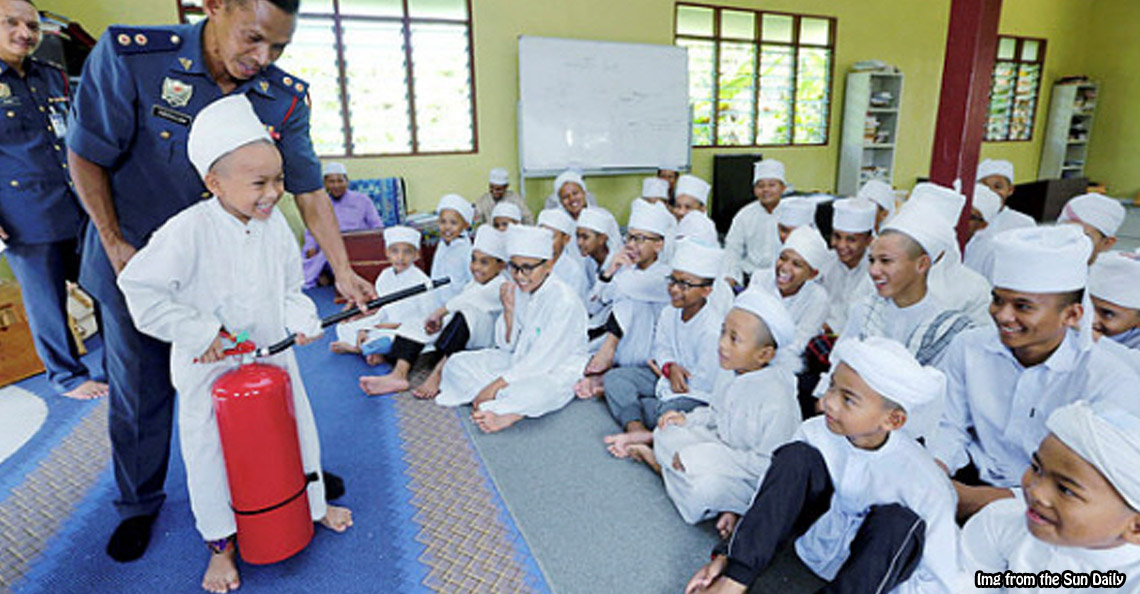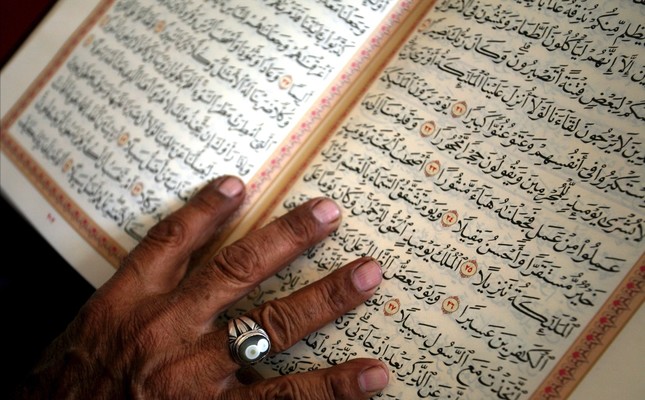So.. what kinda future do students from Malaysian islamic religious schools have?

- 795Shares
- Facebook654
- Twitter26
- LinkedIn23
- Email20
- WhatsApp72
What comes to your mind if you hear people talk about Islamic religious schools, also known as tahfiz schools? Nothing good, perhaps, considering there has been a LOT of bad news concerning tahfiz schools lately.
You might recall that a tahfiz school burned down sometime last year, killing more than 20 students and wardens. Or you might remember Mohamad Thaqif Amin Gaddafi, a tahfiz student who was allegedly abused at his school, and died not long after.
And very, very recently, a tahfiz school teacher was arrested… for forcing oral sex on a 14-year-old student.

With news such as these, it’s not hard to see tahfiz schools in a bad light. Perhaps that’s why a few days ago, Tan Sri Zainuddin Maidin, a former minister, suggested that all tahfiz schools be closed down. This, he said, is a step to bring Muslims away from backdated religious practices.
“I would like to bring to the attention of Dr Mujahid (Datuk Dr Mujahid Yusof Rawa, a Minister in the Prime Minister’s Department) that the reason behind my suggestion to close down all private tahfiz schools in the country is that they have become a sort of business among ustazs (Muslim religious teachers),” – Tan Sri Zainuddin Maidin, translated from Sinar Harian.
He also felt that tahfiz schools would not ensure a bright future for the new generation of Muslims, but Dr Maszlee Malik, our new Education Minister, said that Zainuddin’s view is too radical.
But really, what’s the deal with tahfizs anyway? Are they really that backdated? Can children sent to tahfiz schools make a living when they graduate?
To answer all that, our BM friends over at Soscili interviewed the principal of of Maahad Tahfiz An-Nabawi in Shah Alam, Ustaz Mohd Najmi Inchik Hashim to get an inside look at Malaysian tahfizs. The first thing you should know is…
Their curriculum centers around memorizing the Quran. All 604 pages of it.

For non-Muslims (as well as some Muslims), tahfiz schools might be as mysterious as Shaolin temples to people who have only seen it in kung fu movies. So let’s start with the basics. The word ‘tahfiz’ itself means the act of memorizing the Quran (the Islamic holy book), so a tahfiz school is generally any school with a focus on memorizing all 604 pages of this Arabic text.
As for why the focus on memorization, back in the early days of the religion, the Quran was passed down orally (writing and reading weren’t big back then), so followers who could memorize and recite the scripture are well respected. Even today, with the availability of the Quran both online and in print, hafizs (people who know the Quran by heart) are venerated as protectors of the script’s originality.
But just like how Shaolin monks don’t practice kung fu all the time, memorizing isn’t all that tahfiz students do. There are a lot of tahfiz schools in Malaysia, and the curriculum can differ based on whether it’s a government institution or a private one. Ustaz Najmi told us that while the government determines what government tahfiz schools teach their students, the curriculum of private tahfiz schools can generally be classified into two broad systems: diniah tahfizs and academic tahfizs.

Diniah tahfizs focus a lot on memorizing the Quran plus other religious studies like sirah (Islamic history), akidah (faith), tauhid (oneness of God) and the Arabic language. Academic tahfizs, on the other hand, teach regular school subjects (math, science, etc) in addition to Quran memorization. However, diniah tahfiz students may still take the SPM, only their schools may or may not provide the classes for it. For schools that don’t, the students may have to get private tuitions. Still other schools offer fast track classes for their SPM candidates, cramming in two years’ worth of knowledge into one year.
So yeah, in essence, a tahfiz school graduate may or may not know their Pythagoras theorems and photosynthesis and other things regular school students learn, depending on which kind of tahfiz school they went to. But then again…
Why do parents choose tahfiz schools in the first place?

Despite public schools being somewhat free, tahfizs are gaining popularity, and a lot of parents choose to pay extra for a tahfiz education for their child. Part of the reasons cited include their belief that public schools are unable to build character or strengthen religious beliefs in their children. During his years of being principal, Ustaz Najmi had interviewed quite a number of hopeful parents and their students, and based on his experience, there are a few reasons why a parent might send their children to tahfiz schools.
One of them was that they may feel that there’s not enough control on their children in public schools, so they choose a tahfiz school as they believe it might shape their children for the better. Other parents may believe that their children can’t cope with the academic subjects in public schools, so they enroll their children in tahfizs, even if the child has no interest in it. The third one has something to do with glamour.
“…now we see a lot of religious issues and programs (on television) that can be a shortcut for people towards glamorousness. So when their child is knowledgeable, (they) can enter such shows and become an express ustaz.” – Ustaz Mohd Najmi, Principal of Maahad Tahfiz An-Nabawi, Shah Alam. Translated from SosCili.
Yet other parents enroll their children simply because they want their child to be able to memorize all of the Quran. Regardless of why, the Straits Times had cited that a lot of students end up becoming ustazs after they graduate, or pursuing courses in universities that has something to do with Islam, like a prayer leader or a syariah lawyer. However…
Times have changed, and some tahfizs have realized that, too.

So after you memorize the holy book, what now? Well, tahfiz students can then get certified for it. Based on JAIS guidelines, it only recognizes two tahfiz certificates, JAKIM’s Sijil Tahfiz Malaysia (STM) and a state’s Sijil Menengah Agama Tahfiz Al-Quran. So these certs may be used to advance into the college or university levels, but in religious courses, of course.
“To advance a student’s studies outside the country, it depends (on their certificates). For us, we would try and find students who qualify for that and draw up an MOU with the destination, with their consent. For example, if we’re sending a student to South Africa, we have to check whether they accept our certification.” – Ustaz Mohd Najmi, translated, to SosCili.
But lately, with reports of bad things happening in tahfizs, the government has started to pay attention to these schools and decided that they have to be as good as public schools, if not better. Zahid Hamidi had called for tahfiz school graduates to equip themselves with professional skills as well, apart from their ability to memorize the Quran. Besides Zahid, Najib Razak had also came up with the National Tahfiz Education Policy that aimed to produce 125,000 tahfiz graduates skilled in various fields like medicine, engineering, banking and others by 2050.

Besides sprinkling money at registered tahfiz schools and getting unregistered ones to register, the plan also involved introducing new curriculum models to be used by all tahfiz institutions in the country. Besides the central memorizing thing, the modules will include other stuff based on what the instructors’ field of study was. The modules include Tahfiz Turath (plus studies of the Turath), Tahfiz Sains (plus science subjects), Tahfiz Dini (plus Islamic subjects) and Tahfiz Kemahiran (plus skills studies).
So just because a person studied at a tahfiz, it does not mean that they have to be all ustaz-y and religious-y.
“…one of my former students is now an engineer… So a tahfiz student does not have to necessarily become an ustaz. He (or she) can go into other fields, as long as he carries the Quran within himself.” – Ustaz Mohd Najmi, translated from SosCili.
But although some tahfiz schools have advanced…
A lot of tahfiz schools are still plagued by issues, and that needs to stop soon

As the burning tahfiz incident had highlighted, the level of safety also varies among tahfiz schools. Last year’s check by the Ministry of Housing and Local Government found that out of 1,238 tahfiz centers nationwide (mostly ones registered with the government), only 80 of them had their buildings approved by the Bomba. They had to issue 367 notices requiring unapproved tahfizs to fix things like wiring, escape routes, smoke detectors and fire extinguishes, among others. And these 1,238 tahfiz centers are just a fraction of the total number of tahfizs in Malaysia.
The exact number of tahfizs in Malaysia are unknown, as a lot of them are unregistered. The government is aware of this problem, so they came up with the National Tahfiz Education Policy. However, you can’t really help something that you don’t even know existed, so the first step would be to get all these private tahfiz schools out of the woodwork and register with the government. But it’s not an easy thing to do.
“It is one of the five core aspects we are focusing on, and while part of it does address ways to provide financial aid to tahfiz schools, our challenge now is to ensure privately-owned schools are registered with state religious departments. The Fire and Rescue Department’s recent checks were done on 1,238 tahfiz schools but Jakim’s statistics show that only 608 of these are registered as of June this year,” – Datuk Dr Asyraf Wajdi Dusuki, to the Star.

As for why, earlier this year Datuk Seri Ahmad Zahid Hamidi had said that the reason is because they’re afraid of not being able to comply to the authorities’ standards in safety. He went on to say that the federal government had limited power to enforce such standards to tahfiz schools, as they are under the purview of state religious authorities.
The Perlis Mufti, Dr Asri Zainul Abidin, had said that the quality of such institutions needs to be fortified as many religious institutions still employ untrained teachers of low quality.
“Some ustazs even failed in his own education, yet they opened schools without a certificate of adequate education training, let alone a teaching diploma or certificate. This ends up with them becoming educators with neither enough knowledge nor the methods or pedagogy of education.” – Prof Madya Dr. Asri Zainul Abidin, Perlis Mufti.
Regardless of that, with so many voicing their opposition to tahfiz schools being closed down, a solution needs to be drawn up regarding the state of tahfiz schools in Malaysia, so that tahfiz schools will no longer be associated with fire tragedies and abuse.
“In my opinion, we shouldn’t associate tahfiz schools with negativity. We should instead help these tahfiz schools, help raise up their students. Whatever we can help with, we should help. Tahfiz schools aren’t perfect, and so are people.” – Ustaz Mohd Najmi, translated from SosCili.
- 795Shares
- Facebook654
- Twitter26
- LinkedIn23
- Email20
- WhatsApp72



